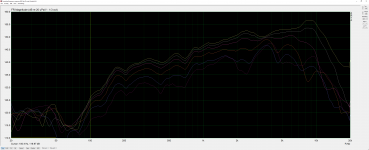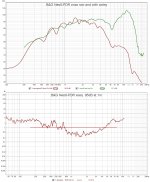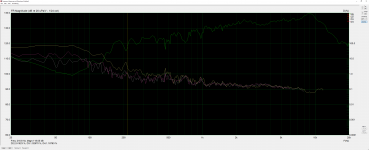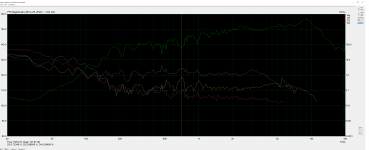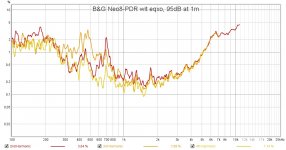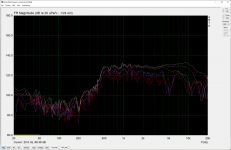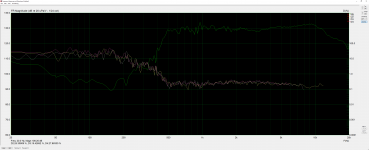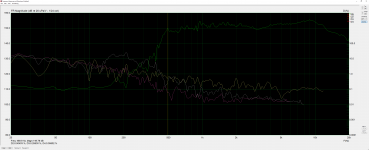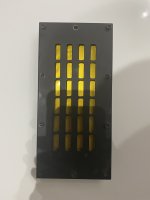For sure, dipole sound is wonderful because of the back sound. Duh. But the driver(s) aren't living by the same rules of dispersion, flat FR, etc. but creating less-focused ambient sound.
Actually, that's not right unless you consider your hearing process to be akin to a microphone. That line of thought has gotten many people into trouble.
What are you trying to say about the "rules of dispersion, flat FR, etc"? What are those, exactly?
In terms of one's hearing, a proper dipole speaker is no less "focused" than a horn system in a dead room. Hearing is much, much more complicated than just first arrival sounds, eh?
I'm the very last person on the list to erroneously think the human hearing is like a mic.
I was referring to the priorities for making sound coming out the back where, for example, fine dispersion isn't important.
Yes, needs a thread of its own, but I find my large panel ESL dipoles remarkably good for localization (not to mention ambient sound too). My panels are just over a foot apart in my small-size set-up. Any more space and just ping-pong stereo.
B.
I was referring to the priorities for making sound coming out the back where, for example, fine dispersion isn't important.
Yes, needs a thread of its own, but I find my large panel ESL dipoles remarkably good for localization (not to mention ambient sound too). My panels are just over a foot apart in my small-size set-up. Any more space and just ping-pong stereo.
B.
I'm the very last person on the list to erroneously think the human hearing is like a mic.
I was referring to the priorities for making sound coming out the back where, for example, fine dispersion isn't important.
OK, I am never sure if your comments are serious, or are dripping with sarcasm and you mean the opposite! 😀 I am certainly a proponent of careful consideration of what is happening to the rear of a dipole, to the point of trying to make front and rear radiation identical.
Getting back to SL, he told me once (in personal conversation) that he just wanted to "let the sound out" of the rear of a dipole speaker. I think at the time he was primarily interested in removing the effect of the cabinet, such as internal resonances, re-radiation of sound back thru the cone, panel resonances, etc. I think that he may be been less concerned about what was happening to the rear, exactly. For example if you look at his LX521, he uses a 4' driver, the SEAS MU10RB-SL, as the "upper mid". He uses this driver all the way up to 7kHz (!) before crossing over to the front-back tweeter pair. I very much doubt that the upper mid looks the same to the rear above 2kHz or so, but I think this did not concern him all that much at the time.
Yes, needs a thread of its own, but I find my large panel ESL dipoles remarkably good for localization (not to mention ambient sound too). My panels are just over a foot apart in my small-size set-up. Any more space and just ping-pong stereo.
B.
I hope to someday hear ESLs or other large panel electrostatics to see/hear what all the fuss is about!
Hi all,
I made some measurements of a planar driver (I'll tell you later which it is 🙂 )
The measurements are - from top to bottom 0° - 15° - 30° - 45° - 60° -75°, measured at a distance of about 80cm.
For a dipole loudspeaker in the sense of the idea of this thread, what would be - from your point of view - the usable range, considering only the frequency response?
The lower end of the usable range will most probably be determined by the distorsion measurements, so I would be particulary interested in your opinion about the maximum upper crossover frequency.
What would be perfect / very good / acceptable)?
Best regards
Matthias
I made some measurements of a planar driver (I'll tell you later which it is 🙂 )
The measurements are - from top to bottom 0° - 15° - 30° - 45° - 60° -75°, measured at a distance of about 80cm.
For a dipole loudspeaker in the sense of the idea of this thread, what would be - from your point of view - the usable range, considering only the frequency response?
The lower end of the usable range will most probably be determined by the distorsion measurements, so I would be particulary interested in your opinion about the maximum upper crossover frequency.
What would be perfect / very good / acceptable)?
Best regards
Matthias
Attachments
You need to tell us more about the measurement. Is the driver the same front and back? On a baffle or self-baffled or hanging from a string? In a room or out of doors? Near a wall? Type of mic?
B.
B.
Hi all,
I made some measurements of a planar driver (I'll tell you later which it is 🙂 )
The measurements are - from top to bottom 0° - 15° - 30° - 45° - 60° -75°, measured at a distance of about 80cm.
For a dipole loudspeaker in the sense of the idea of this thread, what would be - from your point of view - the usable range, considering only the frequency response?
The lower end of the usable range will most probably be determined by the distorsion measurements, so I would be particulary interested in your opinion about the maximum upper crossover frequency.
What would be perfect / very good / acceptable)?
Best regards
Matthias
It might be possible to use all or part of this range. To me, the metrics that limit the frequency range within which a particular driver can be used are:
- Distortion: A driver may have output, but if the distortion is too high at the SPL level that you wish it to reproduce then it is not suitable. I typically set a limit of 1% distortion at a relatively high SPL level compared to what the driver might experience in the loudspeaker system to set frequency limits based on this criteria
- Directivity: The curves in your measurement appear to show relatively constant directivity, except around 3.5kHz. It is up to the designer to decide whether this kind of response pattern change is acceptable in the loudspeaker system, or if the driver should be crossed over to another one above/below the problem area in order to exclude it
- The Need for Frequency Response Shaping: for example in your measurement, the response tilts down towards low frequency, amounting to about 15dB between 200 Hz and 2k Hz. This will need to be equalized (flattened) as part of the crossover, especially if the band is wide. How will that be done? The signal to the driver can be lifted (power is increased) or cut (power is reduced) to shape the response. If lifting, how will the driver respond with more power applied (e.g. will distortion increase at higher SPLs?) and will the higher power exceed the amount that the driver can dissipate safely?
- Other Performance Metrics: Does the driver have ringing or energy storage issues within the passband? A cumulative spectral decay ("waterfall") plot or burst decay plot (a la Linkwitz) can reveal problems like these.
Apart from the frequency responses, a few additional measurements ( especially distortion) are needed to really know the useful range of this driver. So far it is looking good. Can you get and post some more data?
@bentoronto: ok, here you are...
Though measurements neither are 100% accurate, nor calibrated, the shown picture should be good enough to show the general behaviour of the driver.
- it is a planar driver, open back, front and back radiation can be considered as nearly identical.
- measurements were done in my living room (7.5*7.5m), with at least 2m distance to all walls
- height above floor was about 1m, for both, the microphone and the driver
- driver and microphone stayed at the same position during all measurements, only the driver itself was turned around according to the angle to be measured
- the driver was measured without any baffle, except that it was mounted on top of a 30cm wide baffle with the woofers, which are intended to play below this driver. So it was 'nude' to the top, left, right, but not to the bottom edge
- microphone used was a Beyerdynamic MM1, with an individual calibration file to correct the frequency response.
Though measurements neither are 100% accurate, nor calibrated, the shown picture should be good enough to show the general behaviour of the driver.
Well, well, well... a very worthwhile contribution.
My first impression is that readers of this thread will now realize that their intuitive notion of how dipoles work - based on textbook physics - is misleading. There is little indication that the rear wave is sneaking around and cancelling the front wave*, at least in the band tested here and right to 80 degrees. The drop is small and hard to proportion to wavelengths, it is not the expected drop as the freq does down the scale. On the contrary, the polar response in your room and as tested is really good.
I think the intuitive feel people have is that at some freq related to the dimensions of the baffle, the response drops off a cliff. And you must insert a Linkwitz correction. Unless your secret driver is a lot larger than I imagine, there is no drop-off point even for a rectangular driver that ought to show one.
Now a days, with woke audiophiles using DSP, we look for orderliness, transient speed, and low distortion; because freq bumps and dips and trends (like your plots) can be easily adjusted, assuming they still appear when measured at listening chairs.
Just a first rough peek at the drivers, but those curves look pretty good to me.
B.
*DIY posters are always forgetting that dipoles ought to be adding together exactly as often as cancelling together; must be some kind of natural pessimism here.
My first impression is that readers of this thread will now realize that their intuitive notion of how dipoles work - based on textbook physics - is misleading. There is little indication that the rear wave is sneaking around and cancelling the front wave*, at least in the band tested here and right to 80 degrees. The drop is small and hard to proportion to wavelengths, it is not the expected drop as the freq does down the scale. On the contrary, the polar response in your room and as tested is really good.
I think the intuitive feel people have is that at some freq related to the dimensions of the baffle, the response drops off a cliff. And you must insert a Linkwitz correction. Unless your secret driver is a lot larger than I imagine, there is no drop-off point even for a rectangular driver that ought to show one.
Now a days, with woke audiophiles using DSP, we look for orderliness, transient speed, and low distortion; because freq bumps and dips and trends (like your plots) can be easily adjusted, assuming they still appear when measured at listening chairs.
Just a first rough peek at the drivers, but those curves look pretty good to me.
B.
*DIY posters are always forgetting that dipoles ought to be adding together exactly as often as cancelling together; must be some kind of natural pessimism here.
Last edited:
@Charlie,
thanks for your suggestions.
with the design goal to have a (horizontal) dipole behavior as good as possible, I could imagine, that the behavior of that driver at 3500Hz is not really acceptable. However, I have no real experience or comparisons to assess, if this would cause an audible problem.
Assuming, that I add a dipole tweeter, which has a very good constant directivity, I wonder, at which point I should crossover to be safe.
It is not only the behavior at 3500Hz where I'm asking myself, if this is compromising the dipole radiation, maybe also the frequency range above 2000Hz, where the driver shows increased beaming.
0°/15°/30° are very good, but with increasing angle it does not look as good anymore.
But is this really relevant?
By the way, I will use the software Acourate to design my crossovers.
So nearly every imaginable filter will be possible, even Neville-Thiele or the fantastic proprietary filters designed by Uli Brüggemann, which I mentioned one year ago in this thread: Neville Thiele xover filter discussion
thanks for your suggestions.
with the design goal to have a (horizontal) dipole behavior as good as possible, I could imagine, that the behavior of that driver at 3500Hz is not really acceptable. However, I have no real experience or comparisons to assess, if this would cause an audible problem.
Assuming, that I add a dipole tweeter, which has a very good constant directivity, I wonder, at which point I should crossover to be safe.
It is not only the behavior at 3500Hz where I'm asking myself, if this is compromising the dipole radiation, maybe also the frequency range above 2000Hz, where the driver shows increased beaming.
0°/15°/30° are very good, but with increasing angle it does not look as good anymore.
But is this really relevant?
By the way, I will use the software Acourate to design my crossovers.
So nearly every imaginable filter will be possible, even Neville-Thiele or the fantastic proprietary filters designed by Uli Brüggemann, which I mentioned one year ago in this thread: Neville Thiele xover filter discussion
Ok, I do not want to make any secrets here about this driver 😉.
The driver is a very well known one, especially for many participants of this thread.
I just wanted to get your opinions based on my actual measurements, not on statements and assumptions, which had been made before in the past, as these are often very different and sometimes contradictory.
The measurements are from a 'New old stock' BG Neo10, more than 10 years old, but never used before.
There are many different statements about, in which range the driver can be used.
But with the goal in mind to achieve the best possible (horizontal) dipole directivity behavior of the speaker overall (according to the topic of this thread), I guess, its usable range is much more restricted.
The driver is a very well known one, especially for many participants of this thread.
I just wanted to get your opinions based on my actual measurements, not on statements and assumptions, which had been made before in the past, as these are often very different and sometimes contradictory.
The measurements are from a 'New old stock' BG Neo10, more than 10 years old, but never used before.
There are many different statements about, in which range the driver can be used.
But with the goal in mind to achieve the best possible (horizontal) dipole directivity behavior of the speaker overall (according to the topic of this thread), I guess, its usable range is much more restricted.
...However, I have no real experience or comparisons to assess, if this would cause an audible problem.
Assuming, that I add a dipole tweeter, which has a very good constant directivity, I wonder, at which point I should crossover to be safe....
Those curves are quite good, esp for something with as wide a band and esp polar.
Unlike the stupid way we use woofers, the goals are (1) to keep the driver's resonance out of play (where sound and longevity can be compromised) and (2) to eliminate where the driver's FR seems faulty. And apropos high end, not to sweat getting full output once over 10kHz, only your dog will notice.
The slope of the XO is what determines how far away the crossover must be. My guess is that builders tend to underestimate how much bad sound is coming out of mid and upper range drivers due to the XO not being high enough or sharp enough.
B.
That's the thing about no compromise goals. 🙂But with the goal in mind to achieve the best possible (horizontal) dipole directivity behavior of the speaker overall (according to the topic of this thread), I guess, its usable range is much more restricted.
It looks to my old eyeballs that it can handle 200-12kHz very fine (which would need maybe a 500 Hz XO. That's a lot. Maybe not loud. Distortion? Hate to admit it, but some of those planars could compete with ESLs, almost.
Easy to have inflated expectations looking at marketing communications, textbook diagrams, and sims.
BTW, various clones now available. See the Planars forum.
B.
Easy to have inflated expectations looking at marketing communications, textbook diagrams, and sims.
BTW, various clones now available. See the Planars forum.
B.
Hi, I was pretty sure it was a Neo8 or Neo10 or clone.
I use Neo8 nude dipole with LR2 800/3500Hz, measurements below. Distortion in low end and nonlinear dispersion in upper end are limiting factors. Crossover steepness is also important when considering xo points.
I use Neo8 nude dipole with LR2 800/3500Hz, measurements below. Distortion in low end and nonlinear dispersion in upper end are limiting factors. Crossover steepness is also important when considering xo points.
Attachments
It looks to my old eyeballs that it can handle 200-12kHz very fine (which would need maybe a 500 Hz XO. That's a lot. Maybe not loud. Distortion? Hate to admit it, but some of those planars could compete with ESLs, almost.
Easy to have inflated expectations looking at marketing communications, textbook diagrams, and sims.
BTW, various clones now available. See the Planars forum.
B.
At the moment, I'm not able to callibrate my measurement system, so I can only provide two measurements, which I called 'normal' and loud'.
Meaningfulness is limited, but at least it shows a tendency.
And it shows exactly, what Juhazi is writing:
Distortion in low end and nonlinear dispersion in upper end are limiting factors. Crossover steepness is also important when considering xo points.
Especially D3 at the lower frequencies is significantly increasing with higher volume.
Fortunately, with Acourate Convolver, I am able to switch between to crossover profiles very fast.
So if necessary, I would be able to switch between different crossover profiles for different volume levels.
Last edited:
Motivated by this interesting conversion, I remembered myself, that I still have a very old pair of prototypes of the famous Fostex FS21RP in my collection.
The difference between the prototype and the original driver is, that it has no front panel and therefore the width is only 120mm instead of 159mm.
This makes it even more interesting for a true (horizontal) dipole speaker.
So I measured them, just for comparison.
Find the files attached.
I'm somehow shocked in a positiv way. This driver looks much better over a wide range than the Neo10.
So maybe, for the purpose we are discussing here, the better choice.
The difference between the prototype and the original driver is, that it has no front panel and therefore the width is only 120mm instead of 159mm.
This makes it even more interesting for a true (horizontal) dipole speaker.
So I measured them, just for comparison.
Find the files attached.
I'm somehow shocked in a positiv way. This driver looks much better over a wide range than the Neo10.
So maybe, for the purpose we are discussing here, the better choice.
Attachments
If the Fostex are not designed to go as low as the planars, that's an advantage that shows up in their FR and HD.
Some fried egg tweeters measure really well too. I once made an array of 9 per side and never before had brass instruments sound as good. And perhaps PE has 9 dome tweeters for the price of one planar with neodymium magnets.
And into the mix of issues is XO point. Really swell to have one driver go from 120 Hz to 3kHz rather than a break in the middle of the music band and requiring endless arguments about crossovers in this forum.
B.
Some fried egg tweeters measure really well too. I once made an array of 9 per side and never before had brass instruments sound as good. And perhaps PE has 9 dome tweeters for the price of one planar with neodymium magnets.
And into the mix of issues is XO point. Really swell to have one driver go from 120 Hz to 3kHz rather than a break in the middle of the music band and requiring endless arguments about crossovers in this forum.
B.
- Home
- Loudspeakers
- Multi-Way
- In Pursuit of a 20-20k Dipole Loudspeaker
